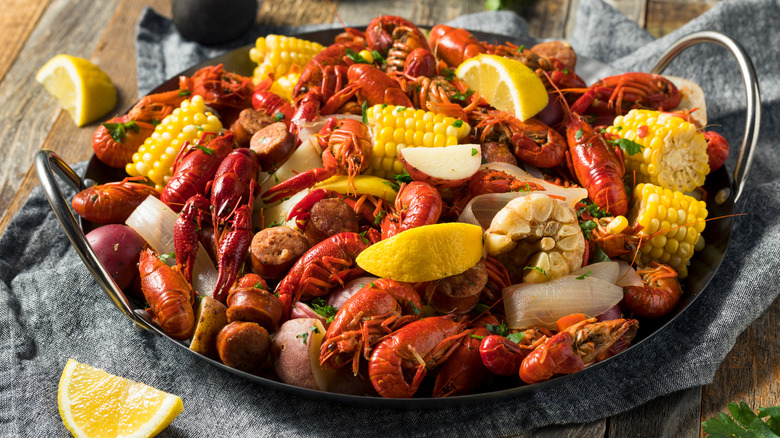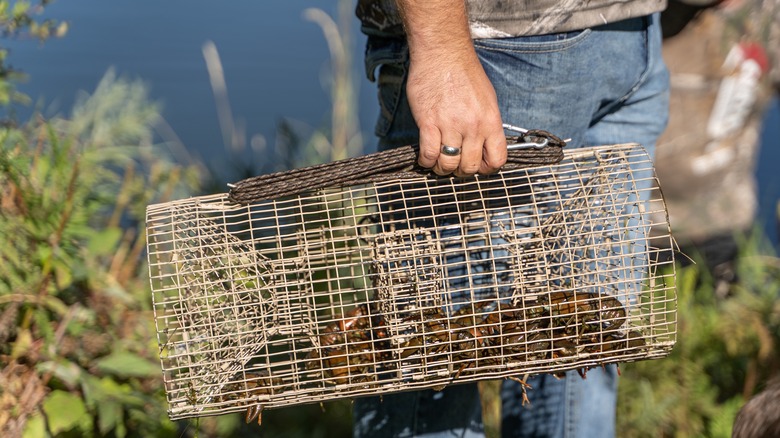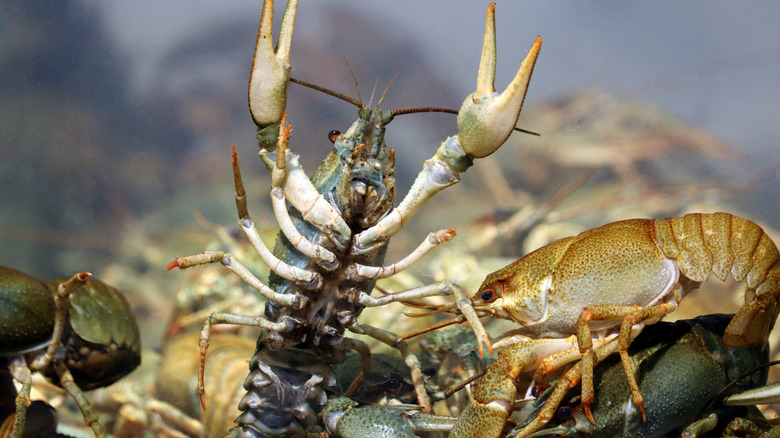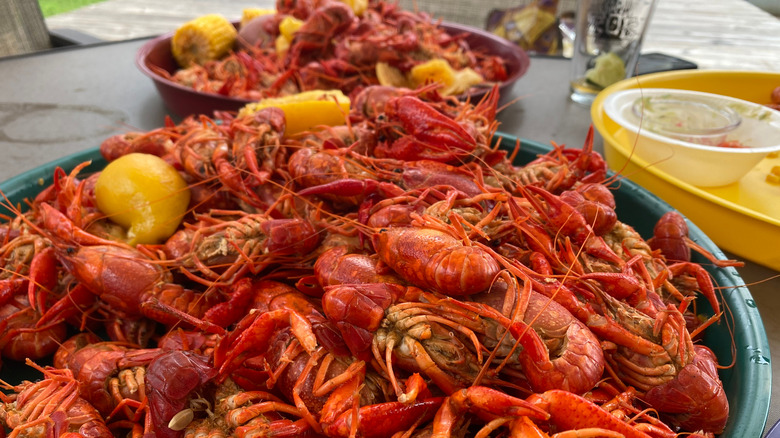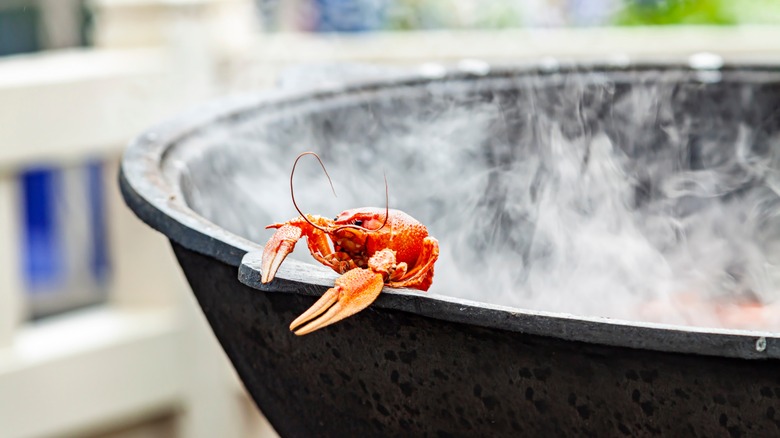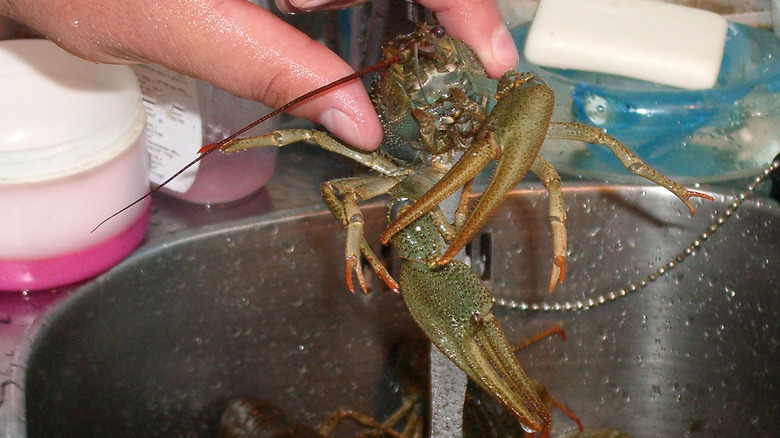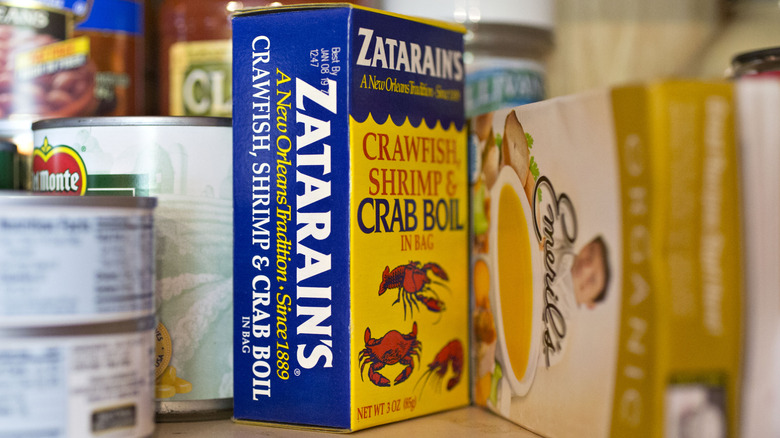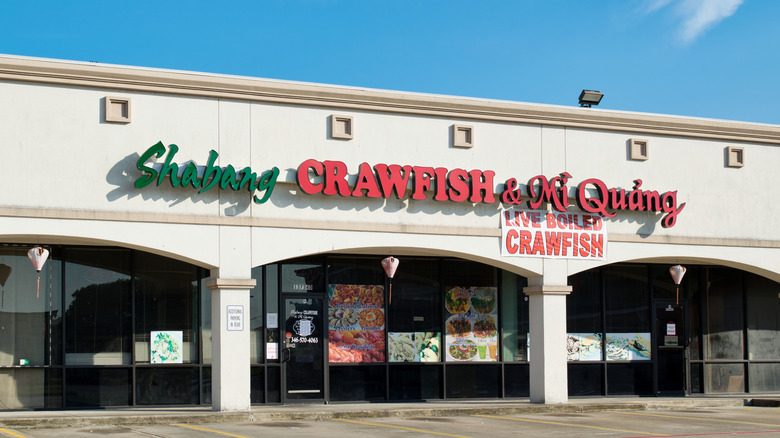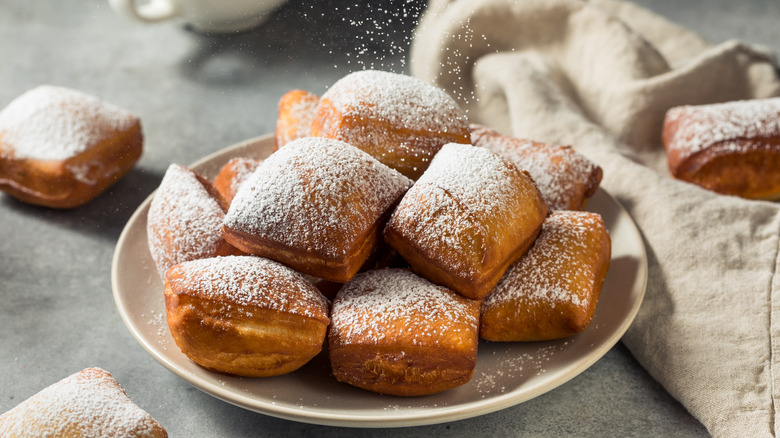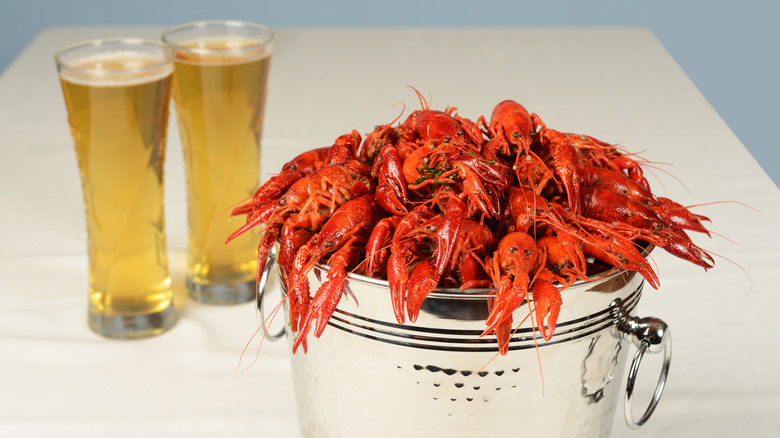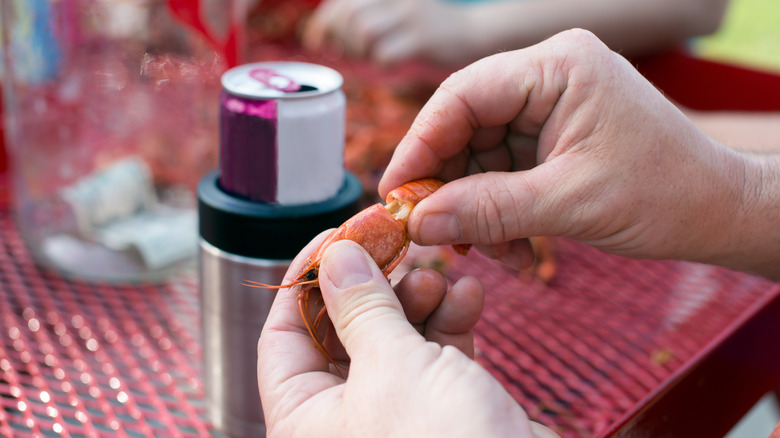Your Guide To Hosting A Crawfish Boil
If you grew up in Southern Louisiana or along the Gulf Coast, you could probably host a crawfish boil in your sleep. But for the rest of us, hosting a boil is something we've only done sporadically, if at all.
Crawfish boils are a Cajun tradition that's like a backyard barbecue, but instead of throwing hot dogs on the grill, you throw crawfish into a boiling pot of water. When you do it right, crawfish boils are down-and-dirty affairs. You won't need crab crackers or any special tools. Just your own two hands. If you're not sure how to host a boil, you should know that they aren't super complicated. With a bit of knowledge and some planning, you can easily be pouring out a pot of perfectly cooked crawfish for all of your guests to eat. Then, with a bit of practice, you'll be hosting boils like a dyed-in-the-wool Cajun.
Try to get crawfish when they are in season
As we learned with the cancellation of the Alaskan snow crab season in 2022, the availability of seafood depends on factors outside our control. If winter weather is warm and wet, the crawfish season can stretch from November to July. According to Farm Progress, crawfish are less likely to fall for baited traps when the water temperature falls below 60 degrees Fahrenheit. This is because crawfish burrow into mud, and go dormant to survive cold temperatures. If temperatures remain below 60 degrees for an extended period, adult crawfish will die off, making it harder for juveniles to replace them.
There is a sizeable crawfish farming industry, but the availability of farmed crawfish rises and falls based on the availability of fresh-caught crawfish. On top of that, supply bottlenecks can lead to overcrowded farms. When this happens, the average size of the crawfish decreases.
However, the most dependable time to get crawfish is from late February to early May. Probably the best way to remember this is to associate crawfish with Mardi Gras. If you're dragging out your beads and mixing up batches of hurricanes, you can count on fresh crawfish being available.
Get crawfish from a trusted source
If you live in crawfish country, you're probably used to seeing sellers use the word "select" as a way to describe some of their crawfish. According to Arcadia Crawfish, the word "select" only refers to crawfish that have been graded according to their weight, as opposed to ungraded "straight-run" crawfish pulled directly from the traps. Because straight-run crawfish can include small or dead crustaceans, select crawfish are lower maintenance. Select crawfish are graded based on the number of crustaceans per pound, with larger grades meaning smaller crawfish.
Ideally, you should get fresh crawfish from a purveyor or seafood market. However, you can find them at some supermarkets, most notably, the Texas chain H-E-B. During crawfish season, you can expect to find fresh crustaceans at H-E-B. In the off-season, you'll have to settle for frozen or precooked crawfish. Prices for fresh crawfish at H-E-B, as with everywhere else, will vary throughout the season. Early in the season, when supply is low, expect high prices. Peak season is when you'll find the best prices on fresh crawfish, and later in the season prices will tick up as supply drops, while the average size of crawfish increases.
Have enough crawfish for everybody
The amount of crawfish you buy should depend on the hunger and experience level of your eaters. Getting it right will require a little math. The average person eats half a pound of crawfish meat in a sitting. However, a crawfish — as you might have guessed — isn't 100% meat. It varies, but roughly three pounds of crawfish will yield about half a pound of meat.
Another thing to consider is how much you want to make your guests work. A pound of crawfish can contain between 20 and 40 crustaceans. Obviously, the bigger your crawfish, the less work your guests will have to do in order to fill up.
You will have to make adjustments based on whether or not you're serving other food alongside your crawfish boil. On top of that, you shouldn't expect less-experienced eaters to chow down on the average serving size. Finally, it's important to note that fresh, live crawfish don't keep very well, so plan on cooking all of the crawfish that you buy, and possibly refrigerating or freezing any leftover cooked crustaceans.
Make sure you have the right setup
A good crawfish boil starts with some preparation. You could serve up your boil on a large serving tray, but to do it right, you'll need a big table for dumping your boil onto. With this approach, there's no need to drag out the fancy linens for your big table. Simply line your table with newspapers, paper grocery bags, or any scrap paper you may have laying around the house. Speaking of paper, it's also important to have a lot of paper towels on hand. Seafood boils are messy affairs and being a good host means helping your guests stay clean.
Obviously, you're gonna need a big pot. Have one that can fit at least half a gallon of water for every pound of crawfish. You can boil crawfish on your kitchen stove, but a more dramatic approach is to have a large outdoor propane or gas burner. You should also have a large ice chest to keep your crawfish fresh while your water comes up to a rapid boil.
Rinse your critters clean
Crawfish might be delicious, but they are called mudbugs for a reason: They live in mud. According to the Louisiana Department of Wildlife and Fisheries, two species of crawfish are the main focus of commercial harvest. The Red Swamp Crawfish makes up between 70% and 80% of the commercial catch, and it lives in swampy habitats, as its name would suggest. The Southern White River Crawfish makes up the remainder of Louisiana's commercial catch and these critters prefer flooded wetlands with water that flows periodically. Both species can be found in burrows and ditches. They are omnivorous and tend to feed on decomposing plants.
All of this is to say, crawfish live and breathe nastiness, so it's a good idea to wash them before boiling. To do it right, you should have a large tub and a seafood basket that fits inside. Place the seafood basket inside the large tub and dump your fresh crawfish inside. Fill the tub with water and do your best to mix the crawfish around without getting pinched. Dump out the water and repeat this process until the water pours clean. Remember, crawfish are freshwater creatures so rinsing with salt water will kill them.
Use a good boil
When used as a gerund noun, "boil" refers to the seasoning mix used for boiling seafood, and it's hard to mention seafood boil without mentioning the spice company Zatarain's. Founded by the son of Spanish-Basque immigrants in the late 19th century, per About Basque Country, Zatarain's first built a name for itself with Pa-Poose Root Beer. Over the years, the company expanded into selling pickles, spices, and imported olives. Today, the company is owned by the spice giant McCormick and is best known for its zesty spice blends and instant rice products. People who've attended Jazz Fest in New Orleans might also know Zatarian's for its crawfish boil demonstrations at the Cajun Cabin stage (via NOLA.com).
Scour the web for a crawfish boil recipe, and you'll find that many of them include Zatarain's. There's just no escaping it. Recipes for a spicy seafood boil that don't include Zatarain's will mention another packaged spice blend, like creole seasoning or Old Bay. If you're determined to make your boil from scratch, McCormick says the Zatarain's blend includes cayenne, coriander seed, mustard seed, bay leaves, dill seed, allspice, and pepper.
Consider going Viet-Cajun
The term "Viet-Cajun" sounds like something conjured by a foodie's vision quest, but it describes an actual grassroots phenomenon and signifies the ongoing evolution of American food. Driven to the United States in large numbers by the Vietnam War, Vietnamese immigrants that settled in Louisiana found something familiar in the state's seafood boils, in that they evoked the outdoor seafood stalls of their old country. At some point, these immigrants developed their own crawfish boil technique using traditional Vietnamese ingredients. Better economic opportunities in the 1980s and 90s drew many Vietnamese Americans to Houston from Louisiana, and eventually, Houston became known as the epicenter of Viet-Cajun crawfish.
So, what exactly is a Viet-Cajun crawfish boil? Writing for Southern Living, Dan Q. Dao explained that his Vietnamese American family first started hearing about and making Viet-Cajun crawfish in the early 2000s, and today, his family uses a recipe developed by his aunt. It starts just like your typical Cajun boil, with crawfish being boiled in a spice blend. After the crawfish are cooked, they are cooled and then thrown into a container containing a thick sauce made with oranges, onions, garlic, lemon pepper, black pepper, butter, cayenne, and of course, Zatarain's crawfish boil. It's a small but significant variation of the Cajun tradition, yet it's caught on like wildfire. In 2022, McCormick announced its Flavor of the Year was a Vietnamese-Cajun spice blend.
Pick the right add-ins
There are all kinds of things you can toss into a crawfish boil that add flavor and/or cook alongside the crawfish. Speaking with NOLA Weekend, chef and restaurant owner Jason Seither said the most important add-ins for a boil are onion, celery, garlic, bay leaf, and potatoes.
Beyond those essentials, there is a number of different ways you can go. You can add different vegetables, fruit, other seafood, and various types of meat. Seither recommends adding quartered oranges to give the boil sweet heat. He also recommends adding mushrooms, which will readily soak up all the flavors in your boil.
It's important to know when to add different kinds of add-ins. Hard root vegetables like potatoes, carrots, and onions should be added first because they require the longest cooking time. Softer vegetables like corn and fruits should be added early on too because they help flavor the boil for your crawfish. Adding meat should also be done fairly early to ensure it's cooked. If you've never added meat to your boil, you should know that the boil will take on a much meatier flavor profile. Seither also recommends "shocking" your boil with ice and frozen corn after everything has cooked, and allowing the crawfish to soak in the cooled boil for about 20 minutes before serving.
Have some appetizers, side dishes, and desserts on hand
A crawfish boil is basically a one-pot meal, and you really don't have to serve anything alongside it. However, if you are throwing a large party, you will likely have guests who aren't big crawfish fans. In this situation, it's probably a good idea to offer up some appetizers, side dishes, and dessert options. And you really can't go wrong with serving up a few iconic Cajun foods.
Boudin is a traditional Cajun sausage, and the boudin sausage blend is commonly used to make an appetizer known as boudin balls. Although they might be a tough sell, you could also serve grilled bites of alligator meat. Just tell any skeptical guests that it tastes like chicken. Maque choux is a classic Cajun side of chopped corn, bell peppers, onion, garlic, and celery that offers a bright alternative to the rich spiciness of a crawfish boil. If you're inspired by modern takes on classic dishes, you could serve up an easy Cajun poke salad recipe. For dessert, there's nothing more Southern Louisiana than beignets — little squares of fried dough buried under a blizzard of powdered sugar. You could also serve candied pralines, which are crispy, pecan-filled caramels.
Have some beer and/or wine pairings
Crawfish boils are a fairly rustic tradition, but that doesn't mean wine and beer pairings are out of the question. Let's face it: If you offer your guests a shiraz or pilsner to go with their crawfish, it's their loss if they turn it down.
Because crawfish are seafood, your first instinct might be to reach for white wine. However, pairing seafood and white wine is an out-of-date cliche that dates back to a time when red or white were the only two options available. It's fair to say that we have more wine options available to us than ever before, so go ahead and have fun with your wine and food pairings. The only thing to keep in mind is the fact that a crawfish boil has bold flavors, and you need a bold wine to match them.
Beer pairing dinners have become so popular recently that some people are calling beer pairings the new wine pairings. In fact, there are a lot more options for beer and food pairings compared to beer and wine pairings. Some ingredients are very tricky to pair with wine, but the wider range of beer styles means it's much easier to find a pairing. On top of that, the carbonation in beer acts as a palate cleanser and works well in a pairing situation. For a crawfish boil, you really can't go wrong with a crisp, refreshing pilsner, but there are many other styles that work just as well.
Make sure your guests know proper eating technique
Crawfish don't come with instruction manuals, and for the uninitiated, how you're supposed to eat these tasty little critters can be confusing. If you don't explain how to crack and peel crawfish to your newbie guests, they might walk away from the experience frustrated and hungry.
First, show your guests how to grab the crawfish tail in one hand and the head and the other. Then, show them how to pull on the tail where it connects to the rest of the body, separating it slightly before giving the tail a sharp twist. The tail should come off into your hand. Next, show your guests how to suck juicy, flavored boil out of the crawfish head. Finally, show your guests how to peel off the exoskeleton rings keeping the tail meat in place, and remove the meat.
If you're looking to get the most out of you are crawfish investment, you could save the heads and make a stock with them. Another great use for leftover crawfish heads is making crawfish butter, because fat readily absorbs many flavors from a crawfish head.
Have a plan for uneaten crawfish meat
Hopefully there are no leftover crawfish, but if there are, you should refrigerate them as early as possible, and then have a plan. You can easily reheat crawfish and bring back their flavor within five minutes in a hot steamer. Adding any leftover crawfish boil to your steamer pot helps to counteract any flavor that might be lost by using only steam.
If you find that reheating leftover crawfish is a less-than-satisfying approach, you could use leftover tail meat to make mini crawfish pies. These savory treats come in many different forms, including hand pies, single-crust pies, and double-crust pies. Our mini crawfish pie recipe is for a single-crust version that's flavorful, and healthier than the richer double-crust version.
If you're feeling a bit extra, you could also turn leftover crawfish tails and meat into Emeril Lagasse's crawfish dumplings. These "down the bayou" dumplings are made with cilantro, green onion, garlic, and crawfish tail meat. The recipe also includes a dipping sauce made with orange juice, lime juice, fish sauce, chili paste, and sesame oil.
